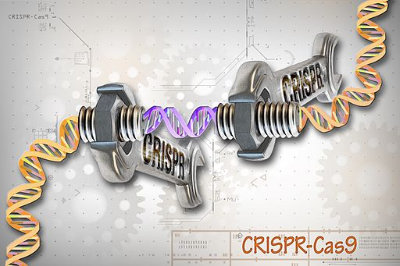
“CRISPR/Cas9 Editing of the Genome” by National Human Genome Research Institute (NHGRI). Licensed under CC BY 2.0.
In mid-December, medical and business news outlets alike were reporting on the formation of a patent licensing alliance among biotech firms and a leading research university. The alliance is composed of firms that have a vested interest in the outcomes of a CRISPR patent interference case currently in front of the U.S. Patent and Trademark Office’s Patent Trial and Appeal Board (PTAB). The interference proceeding specifically involves patents covering CRISPR/Cas9 gene editing technologies. See The CRISPR Clash.
The companies joining the alliance include Ireland-based ERS Genomics and Switzerland’s CRISPR Therapeutics (NASDAQ:CRSP) along with American biotech firms Caribou Biosciences and Intellia Therapeutics (NASDAQ:NTLA). These companies have all licensed CRIPSR/Cas9 technologies, which have been developed by researchers working in the University of California (UC) system and at the University of Vienna. These organizations are on one side of a patent battle being waged against Cambridge, MA-based the Broad Institute and its private biotech partner Editas Medicine (NASDAQ:EDIT).
The case playing out at PTAB is actually a patent interference proceeding held under the terms of Title 35 U.S.C. § 135(a) as it was written before passage of the America Invents Act (AIA) of 2011. AIA changed the U.S. patent system to a first-to-file system from a first-to-invent system, where such interference proceedings are used to determine whether an inventor has a right to an invention despite the fact that the party was not the first to file a patent application for the technology. Because key patents and a patent application involved in the case were published prior to the date that the terms of the AIA went into effect, the case is being held as an interference proceeding. According to an online file on the interference proceedings maintained by PTAB, a notice to declare interference was filed this January.
The outcome of the patent interference case will have a large effect on the future of the CRISPR/Cas9 market, which can include novel treatments for cancer, HIV/AIDS and other diseases which can be culled from human DNA using the gene editing techniques. If the Broad Institute prevails, then PTAB will cancel U.S. Patent Application No. 20140068797, titled Methods and Compositions for RNA-Directed Target DNA Modification and for RNA-Directed Modulation of Transcription. This could open up the companies licensing the CRISPR/Cas9 technologies held by UC and the University of Vienna to future legal action involving Broad Institute’s patents, requiring those firms to license those technologies instead. Reports of the terms of the patent alliance indicate that all companies have entered into a pact under which all companies must agree to any future licensing terms negotiated by any single partner for CRISPR/Cas9 technologies. The most recent filing in the patent interference case came on December 2nd when PTAB issued an order rejecting a request by Broad Institute to conduct a conference call on objections to demonstrative exhibits filed by UC.

![[IPWatchdog Logo]](https://ipwatchdog.com/wp-content/themes/IPWatchdog%20-%202023/assets/images/temp/logo-small@2x.png)

![[Advertisement]](https://ipwatchdog.com/wp-content/uploads/2024/03/IP-Copilot-Apr-16-2024-sidebar-700x500-scaled-1.jpeg)
![[Advertisement]](https://ipwatchdog.com/wp-content/uploads/2024/04/Patent-Litigation-Masters-2024-sidebar-early-bird-ends-Apr-21-last-chance-700x500-1.jpg)

![[Advertisement]](https://ipwatchdog.com/wp-content/uploads/2021/12/WEBINAR-336-x-280-px.png)
![[Advertisement]](https://ipwatchdog.com/wp-content/uploads/2021/12/2021-Patent-Practice-on-Demand-recorded-Feb-2021-336-x-280.jpg)
![[Advertisement]](https://ipwatchdog.com/wp-content/uploads/2021/12/Ad-4-The-Invent-Patent-System™.png)







Join the Discussion
2 comments so far.
Paul F. Morgan
January 6, 2017 11:13 amThanks.
Unfortunately, so far there has been remarkably little, if any, published professional legal analysis I have seen by any interference expert of what may be the most important [and perhaps last] really big PTO interference proceeding?
Merely as one example that would be of interest, normally the longer the time period between the senior party and junior party filing dates, the greater the difficulty [lower odds] for the junior party to prove prior actual reduction to practice or prior conception plus reasonably continuous diligence for a 102(g) valid and sufficiently early pre-filing-date invention date. What is the filing date difference spread here? A senior party could also try to prove its own earlier pre-filing-date invention date. Also, even before any such priority date contest in an interference, either party can raise unpatentability issues by motions in the interference on almost any grounds. Including lack of 112 support for claims which have been declared to be part of the interference.
Dr. Sudhanshu Sekhar Das
January 6, 2017 12:13 amCRISPR is hailed as the major breakthrough in the biotech industry with the entire high-stakes legal dispute about who owns it. With all the money and partnership going on around this technology, it might go all waste as this technology is too naive and fragile. The technology is rapidly evolving with many labs exploring the unknown alternative of CRISPR. Last year in May, Researchers claimed that they could use a protein named NgAgo to cut DNA at a specific site without using a guide (Gao, F. et al. Nature Biotechnol (2016)).
With the potential of transforming the biotech sector CRISPR still hold surprises ahead of us.